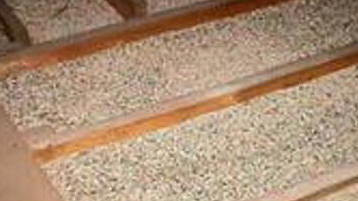VERMICULITE
What is vermiculite?
Vermiculite is a mica-like silver-gold to gray-brown mineral that is mined around the world. In its natural state Vermiculite is flat and shiny. When heated to around 1000 degrees C, it puffs up creating pockets of air. This expanded form is used in a variety of commercial and consumer products, because it is fire-resistant and has good insulation qualities.

So what is the issue with vermiculite?
Vermiculite itself has not been shown to be a health problem. Of concern is vermiculite ore produced by the Libby Mine in Montana from the 1920’s to 1990. This mine had a natural deposit of asbestos which resulted in the vermiculite being contaminated with asbestos. It was sold as Zonolite® Attic Insulation and possibly other brands in Canada, and it is believed that it was installed in approximately 250.000 Canadian homes during that time. Products made from vermiculite ore produced by the Libby Mine were not widely used after the mid-1980’s and have not been on the market in Canada since 1990.
Asbestos can cause lung disease including lung cancer in people who are exposed to airborne particles. Asbestos poses health risks only when fibers are present in the air that people breathe. If asbestos fibers are enclosed or tightly bound in a product, for example in asbestos siding or asbestos floor tiles, there are no significant health risks.
How can I minimize the risk?
Not all vermiculite produced before 1990 contains asbestos fibers. However, to be safe and in the absence of evidence to the contrary, it is reasonable to assume that if a home has older vermiculite-based insulation, it may contain some asbestos.
The best way to minimize asbestos exposure from vermiculite is to NOT remove or disturb the insulation. Moving the vermiculite will cause fibers to become airborne. If vermiculite-based insulation is contained and not exposed to the home or interior environment, it poses very little risk. The following precautions will prevent releasing asbestos fibers into the air:
- Do not use the attic for storage.
- Nobody should go into the attic.
- If you plan to renovate, hire a professional who is trained and certified to handle asbestos.
- Never attempt to remove the insulation yourself.
- Seal all cracks and holes (e.g. light fixtures) in the ceilings to prevent insulation from sifting through.
What if I want to remove it?
Since removal of contaminated vermiculite can be quite costly, it may be a good idea to first have the vermiculite in your home tested. Generally this test costs about $200. If the lab test proves negative for asbestos, then you may well want to just leave the vermiculite in place after all (make sure to hold on to the lab report if you plan to sell your home down the line). If the lab result proves positive for asbestos and you want to remove the contaminated vermiculite from our home, then it is very important that you hire a professional who is specialized in the removal of asbestos products. The cost of removal depends on the size of your attic but may approach $5000 to $10,000 or more to remove and replace the insulation. Homeowners should consider upgrading the insulation and air tightness of their attic at this time to upgrade energy efficiency.
